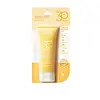What's inside
What's inside
 Key Ingredients
Key Ingredients

 Benefits
Benefits

 Concerns
Concerns

No concerns
 Ingredients Side-by-side
Ingredients Side-by-side

Water
Skin ConditioningCyclopentasiloxane
EmollientTitanium Dioxide
Cosmetic ColorantSynthetic Fluorphlogopite
Cetyl Ethylhexanoate
EmollientGlycerin
HumectantTrimethylsiloxysilicate
EmollientLauryl PEG-10 Tris(Trimethylsiloxy)Silylethyl Dimethicone
EmulsifyingButylene Glycol
HumectantNiacinamide
SmoothingDiisostearyl Malate
EmollientMethyl Trimethicone
Skin ConditioningPentylene Glycol
Skin ConditioningPolypropylsilsesquioxane
PEG-10 Dimethicone
Skin ConditioningDisteardimonium Hectorite
StabilisingMagnesium Sulfate
Phenoxyethanol
PreservativeTriethoxycaprylylsilane
Nylon-12
C30-45 Alkyldimethylsilyl Polypropylsilsesquioxane
Aluminum Hydroxide
EmollientCetearyl Dimethicone/Vinyl Dimethicone Crosspolymer
EmollientCentella Asiatica Leaf Water
Skin ConditioningEthylhexylglycerin
Skin ConditioningDisodium EDTA
Tocopherol
AntioxidantCaffeine
Skin ConditioningCamellia Sinensis Leaf Extract
Antimicrobial1,2-Hexanediol
Skin ConditioningCopper Tripeptide-1
Skin ConditioningWater, Cyclopentasiloxane, Titanium Dioxide, Synthetic Fluorphlogopite, Cetyl Ethylhexanoate, Glycerin, Trimethylsiloxysilicate, Lauryl PEG-10 Tris(Trimethylsiloxy)Silylethyl Dimethicone, Butylene Glycol, Niacinamide, Diisostearyl Malate, Methyl Trimethicone, Pentylene Glycol, Polypropylsilsesquioxane, PEG-10 Dimethicone, Disteardimonium Hectorite, Magnesium Sulfate, Phenoxyethanol, Triethoxycaprylylsilane, Nylon-12, C30-45 Alkyldimethylsilyl Polypropylsilsesquioxane, Aluminum Hydroxide, Cetearyl Dimethicone/Vinyl Dimethicone Crosspolymer, Centella Asiatica Leaf Water, Ethylhexylglycerin, Disodium EDTA, Tocopherol, Caffeine, Camellia Sinensis Leaf Extract, 1,2-Hexanediol, Copper Tripeptide-1
Water
Skin ConditioningEthylhexyl Methoxycinnamate
UV AbsorberPropylene Glycol
Humectant4-Methylbenzylidene Camphor
UV AbsorberAcrylates Copolymer
Polyacrylamide
Butyl Methoxydibenzoylmethane
UV AbsorberDimethicone
EmollientPanthenol
Skin ConditioningCyclopentasiloxane
EmollientTriethanolamine
BufferingPhenoxyethanol
PreservativeC13-14 Isoparaffin
EmollientAloe Barbadensis Leaf Extract
EmollientLaureth-7
EmulsifyingDimethicone Crosspolymer
Emulsion StabilisingCarbomer
Emulsion StabilisingTocopheryl Acetate
AntioxidantDisodium EDTA
Triethylene Glycol
MaskingDimethicone/Vinyl Dimethicone Crosspolymer
Skin ConditioningDimethiconol
EmollientPotassium Sorbate
PreservativeSodium Benzoate
MaskingWater, Ethylhexyl Methoxycinnamate, Propylene Glycol, 4-Methylbenzylidene Camphor, Acrylates Copolymer, Polyacrylamide, Butyl Methoxydibenzoylmethane, Dimethicone, Panthenol, Cyclopentasiloxane, Triethanolamine, Phenoxyethanol, C13-14 Isoparaffin, Aloe Barbadensis Leaf Extract, Laureth-7, Dimethicone Crosspolymer, Carbomer, Tocopheryl Acetate, Disodium EDTA, Triethylene Glycol, Dimethicone/Vinyl Dimethicone Crosspolymer, Dimethiconol, Potassium Sorbate, Sodium Benzoate
 Reviews
Reviews

Ingredients Explained
These ingredients are found in both products.
Ingredients higher up in an ingredient list are typically present in a larger amount.
Cyclopentasiloxane, or D5, is a silicone used to improve texture of products and trap moisture.
D5 is considered lightweight and volatile. Volatile means it evaporates quickly after application. Once evaporated, D5 leaves a thin barrier that helps keep skin hydrated.
It is also an emollient. Emollients help soften the skin and prevent water loss. Silicones create a silky texture in products. D5 helps other ingredients become more spreadable.
Studies show D5 is safe to use in skincare products. We recommend speaking with a skincare professional if you have concerns.
Learn more about CyclopentasiloxaneDisodium EDTA plays a role in making products more stable by aiding other preservatives.
It is a chelating agent, meaning it neutralizes metal ions that may be found in a product.
Disodium EDTA is a salt of edetic acid and is found to be safe in cosmetic ingredients.
Learn more about Disodium EDTAPhenoxyethanol is a preservative that has germicide, antimicrobial, and aromatic properties. Studies show that phenoxyethanol can prevent microbial growth. By itself, it has a scent that is similar to that of a rose.
It's often used in formulations along with Caprylyl Glycol to preserve the shelf life of products.
Water. It's the most common cosmetic ingredient of all. You'll usually see it at the top of ingredient lists, meaning that it makes up the largest part of the product.
So why is it so popular? Water most often acts as a solvent - this means that it helps dissolve other ingredients into the formulation.
You'll also recognize water as that liquid we all need to stay alive. If you see this, drink a glass of water. Stay hydrated!
Learn more about Water